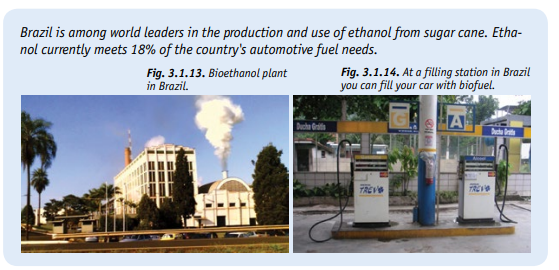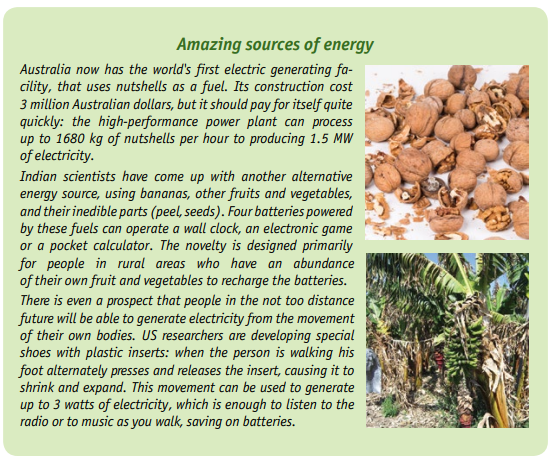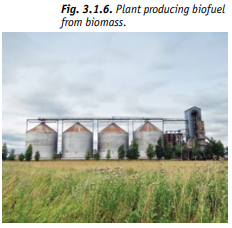
As we have already seen, renewable energy sources use natural processes and resources that are either virtually inexhaustible or are relatively quickly and naturally restored. They include sunshine, wind, flowing water, tidal energy and the heat of the earth. All these kinds of energy are often called ‘alternative’ or ‘green’ because, in contrast with hydrocarbon fuels, they do no damage to the environment and climate. They also include biomass, although it is a special case, for various reasons.
According to the International Energy Agency, about 20% of world production of electric energy now comes from renewable sources. Experts have prepared various scenarios for the development of renewable energy in the future. According to the most favorable scenario, up to 60% of all the electricity can be generated from climate-friendly renewable sources by 2050.
The sun
The sun is the energy source provided by nature herself for the creation of life on Earth. So why not seek ways of using the sun’s energy directly? The midday sun heats every square metre of the earth with capacity of about one megawatt.
Any room with windows grows warm when the sun shines. If the sun is shining in at your window, but it is quite chilly inside the house, open your curtains and wipe any dust off the window glass, and the sun will bring a little more heat into your room. In the old days in European villages, people used wooden shutters on windows. In the daytime the window was opened to let in light and at night it was closed with shutters to keep the captured warmth inside the house.
With the advance of science, people have learnt better techniques to ‘catch the sun’. There are two main ways of using the sun’s energy.

Solar collectors capture the heat of the sun. Water flows along tubes inside the collector and becomes warm (air or antifreeze is sometimes used instead of water). Such collectors can be used for heating buildings and to provide hot water.
Photvoltaic cells are another much-used way of collecting and storing solar energy. Photovoltaic cells convert sunlight into electrical energy. We are all familiar with calculators that use photvoltaic cells and garden lanterns, which collect energy during the day and provide light at night. Large solar energy power stations – so-called ‘solar farms’ – operate using exactly the same principle.

The main advantages of solar energy are that it is freely available, inexhaustible and safe. Solar installations do not emit greenhouse gases or pollutants, so this method of obtaining energy is harmless for the climate.

The disadvantages of solar energy are its strong dependence on the weather and time of day, and high construction costs due to the use of rare elements in solar panels. However, new technologies are gradually reducing the cost of solar installations and broadening the sphere of their application. There are problems associated with the disposal of used solar cells, sincethey contain some toxic substances. A market for the recycling of solar panels has not yet taken
shape, and panels have useful lives of several decades. Another drawback is the consumption of energy and large amounts of clean water for the production of solar panels. Designers are working on new, more environmentally friendly solar cells, and producers need to develop systems for the disposal and recycling of used panels.
Many experts view solar power as the energy of the future and as one of the main alternatives to traditional hydrocarbon energy sources. Governments in many countries support the development of solar energy, and private companies are investing much money in the construction of solar power plants. Although not renowned as a sunny country, Germany has become a world leader in the development of solar energy. Other leading countries in the field are Spain, Italy, France, the USA, Japan and China.
Wind
Wind is another commonly used renewable energy source. The principle behind wind power is that mechanical energy (the energy of movement) can be converted into electrical energy. Miniature windmills and wind-driven toys are fun to play with, but if you build huge wind turbines and place them together in a windy area, the rotation of turbines can generate electricity for public use.
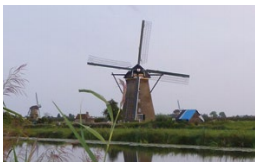
Windmills were used since ancient times, but they became especially popular in medieval Europe. For a long time windmills and water mills were the
only machines known to mankind. Windmills were mainly used to grind corn into flour, to process timber or for irrigation. In the Netherlands, windmills pumped water from land that had been reclaimed from the sea so that the land could be used for agriculture.
Modern wind turbines use a principle analogous to that of windmills.
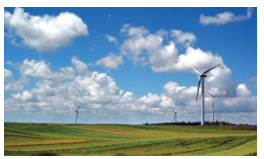
Wind turbines are usually located in coastal areas, where there is constant wind, and it has recently become possible to build such installations at sea as well as on land. So-called ‘offshore wind farms’ are now built at a distance of 10–12 km or more from the coast. Wind turbine towers are set on pile foundations that are driven into the seabed to a depth of 30 m. The latest technologies are for the construction of wind turbines installed on floating platforms.
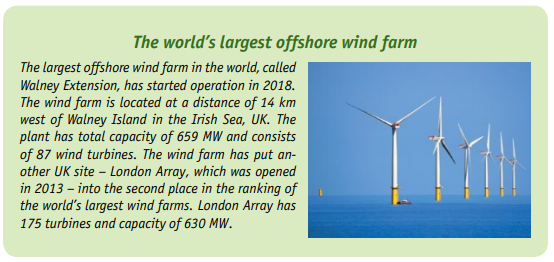
A large wind farm may consist of several hundred turbines extending over a large territory (up to several hundred square kilometers). Wind farms are connected to a country’s electricity grid and transmit electricity over long distances. Smaller wind farms or stand-alone wind turbines can be used to supply electricity in remote districts or to power small facilities.
Wind power now provides only 2.3% of all the electricity consumed worldwide, but it is a rapidly growing source of power as new, more advanced technologies are invented, which allow wind energy to be used more efficiently. Experts from the International Energy Agency predict that wind and solar power together could produce up to 18% of the world’s electricity by 2035.
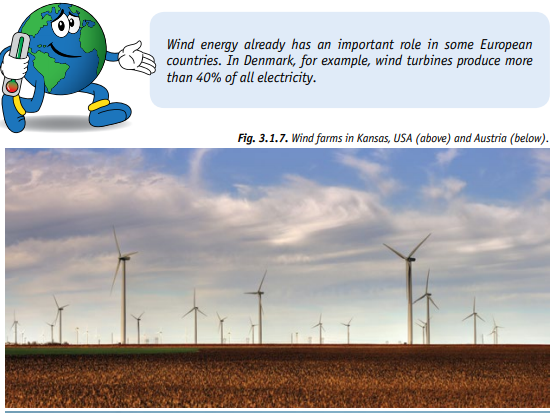
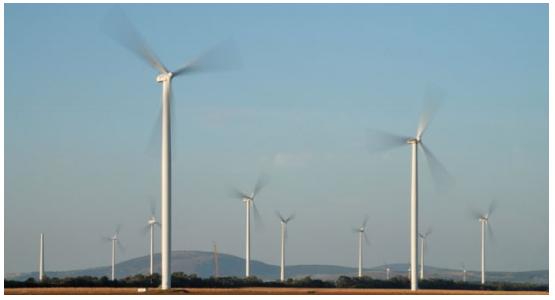
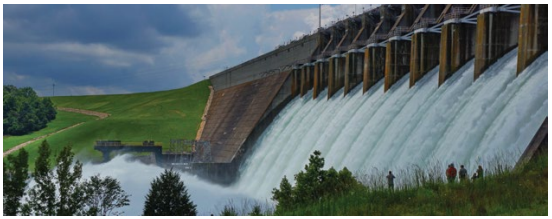
Water
The energy of moving water can be used in many ways. The most common use of water to create energy is hydropower, which works on the same principle as old water mills: the flow of a river rotates a turbine, which produces electrical energy.
This sounds simple, but hydropower has its drawbacks. In order to create a powerful and efficient hydroelectric power plant (HPP), you must build a high dam so that all of the river’s power can be channelled to rotate the turbine blades. The construction of such a dam upsets the natural life of the river: it may alter the river’s microclimate, destroying or harming the animals and plants that live there. So the construction of a hydroelectric power plant must be approached very carefully, paying due attention to environmental balance.
The maintenance of large dams also requires constant attention: if an accident causes the dam wall to burst, the water that is released will gush down the river valley, sweeping away everything in its path, and breaking the banks of the river for miles downstream. For example, the collapse of the Bantsao hydroelectric dam in 1975 in China killed more than 170,000 people.
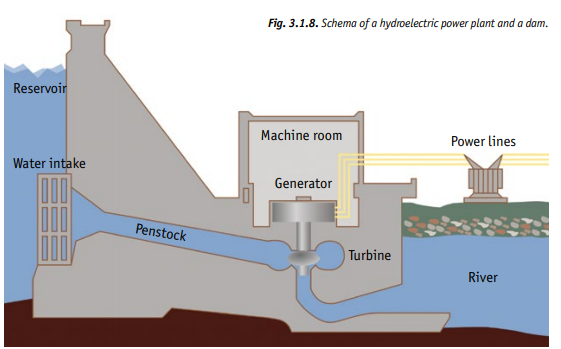

Small hydroelectric installations can operate without a dam (Fig. 3.1.9). They are built on small rivers or even on streams, and store energy in a battery. They have limited power but are adequate to meet the needs of a small farm or essential services at a wildlife reserve located by the river.
Hydropower is safer for the climate than the production of energy at thermal power plants and the cost of electricity generation at a hydropower plant is only
about half of that at a thermal power plant. As a result many countries are trying to maximize the potential of their rivers for energy production and there are
some countries where hydroelectricity provides 90% or even 100% of all electricity (Paraguay, Norway, Tajikistan, Uruguay, Uganda, Zambia, Cameroon and Brazil).
China has a strong commitment to hydroelectric power: up to half of all the world’s small hydropower plants have been built there as well as the biggest hydro plant in the world – the Three Gorges plant on the Yangtze River with capacity of 22.5 GW (Fig. 3.1.10). An even bigger plant, called Grand Inga, with capacity of 39 GW is planned on the Congo River in the Democratic Republic of Congo in Africa.
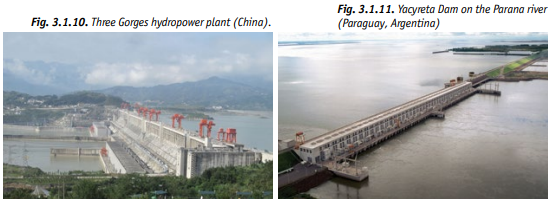
Wave power stations use the energy of waves in the ocean, which is essentially the energy of a float bobbing up and down on the sea. Thus the churning power of the ocean, so dreaded by sailors in the past, can be made to serve us. The power of the waves is dozens of time greater than that of the wind, if it can be harnessed.
Tidal power plants use the extraordinary phenomenon of tides. All of the planets, stars and other celestial bodies are linked by gravity and affect one another. Earth revolves around the Sun and around its own axis, the Moon revolves around Earth, and the respective positions of the Sun, Earth and Moon change all the time. This affects the ocean.
A dam is built at a point across a bay where tides are strong. Initially it prevents the rising water level from entering the bay, until tide level is close to its maximum point. Then a valve is opened, and the ocean water rushes through with great force, turning a rotor. When the water level on both sides of the dam has equalized, the valve is closed again. When the time of low tide comes and the ocean is in full retreat, the trapped water presses to leave the bay, and is allowed back out through the valve, turning the rotor once again.

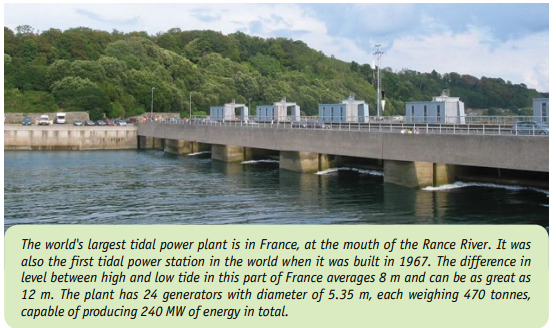
Geothermal energy
Geothermal energy uses heat produced by the earth. It cannot strictly be called ‘renewable’, but the stocks of heat in the depths of our planet are immense. Evidence of the heat contained in the earth is visible in areas of volcanic activity, where hot underground water sometimes rises through cracks in the earth’s surface and occasionally bursts upwards in the form of jets of water and steam known as ‘geysers’.
A borehole can be drilled to hot underwater lakes and their water can be used for heating or electricity generation, and also as a supply of hot water (if the chemical composition of the water is suitable). The particular difficulty associated with hydrothermal energy is that used water must be returned to the ground, since it often contains chemicals that would be harmful if released into rivers and lakes. Another problem is that use of water from underground lakes leaves voids, which could lead to surface subsidence.
Another possibility is to pump ordinary water from the surface via a borehole into hot zones under the ground, where it is heated by a ‘natural boiler’ to boiling point and returns to the surface through an adjacent borehole in the form of steam. This is called petrothermal energy. Petrothermal projects have been developed in the USA, Australia, Japan, Germany and France.
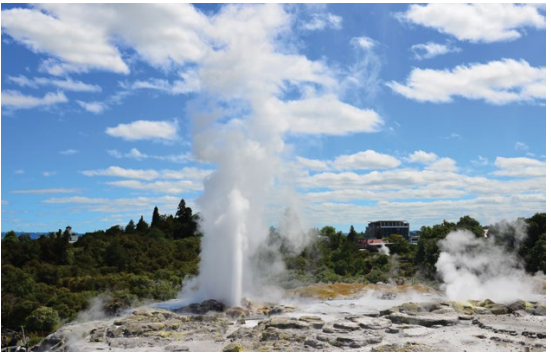
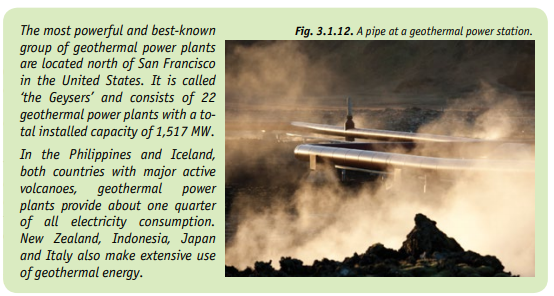
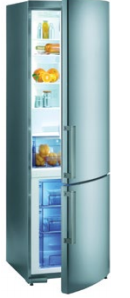
key principle is this: a liquid cooling agent (the refrigerant) absorbs heat from inside the refrigerator and a compressor then sucks and compresses the cooling agent under pressure, outside the refrigerator, so that (in accordance with the laws of physics) the absorbed heat is emitted into the air of the room where the refrigerator is kept. This is why if we touch the outside rear part of a refrigerator, we find that it is hot. It is also the reason why a refrigerator should stand away from heating appliances and not directly in the sun – because it is important that the heat, which it emits, is quickly dissipated in the surrounding air and not retained on the external walls of the refrigerator.
The point of a refrigerator is to retain cold and get rid of heat, but the same operation can also be carried out in reverse, so that heat is retained and cold is discarded. A device which does this is called a heat pump. Heat pumps can absorb heat from weakly heated liquid, air or other substances. They can also ‘take up’ the heat of the earth at shallow depths. If in the winter you pass the warm air coming from your apartment or the used warm water draining out of the bath through a heat pump, a substantial part of the outgoing heat can be returned back to your apartment. However, a heat pump cannot heat water to a very high temperature. The upper limit is usually no
more than 50 or 60 °C, so it is used not as a self-sufficient energy source, but as supplement, which makes it possible to reduce fuel consumption for heating.
Biomass
The living plants that we see around us today are using photosynthesis to accumulate energy from the sun in their bodies. A bonfire or the fire in a fireplace warms us, because a tree that people cut down for firewood spent years capturing energy from the sun and gathering carbon dioxide from the air. Trees have worked for us storing up energy when they were alive, and they finally yield that energy to us when they burn in a fire.
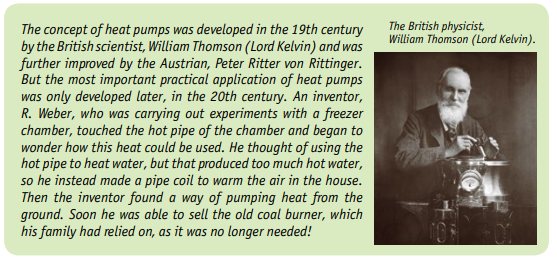
It takes nature several hundred million years to create fossil fuels, so (at the rate we are using them) they are not being replaced. But biomass fuel can be easily replaced: if we cut down an old tree for fuel, we can plant a new one in its place, and in a few decades it will grow into a new tree. Some of the plants and agricultural crops that are used to make fuel grow in one summer or even faster.
But let’s think: many of us have been kept warm and had a nice time sitting around a campfire, or looking at the fire dancing in an outdoor stove in the summer, but how many trees have we planted to pay nature back for that wood? It is simple enough to cut down forests and use the wood. But how often are new trees planted to make up for the ones cut down? It is vital that we do that!

It is not just trees that can be used as fuel. The parts of plants, which are generally considered to be waste, are also good for fuel. For example, the
husks from cotton plants, straw from wheat, and the stones from fruit. During their lives plants absorb about the same amount of carbon dioxide as they release when they are burnt. If they had died in the natural environment instead of being used for fuel, roughly the same amount of gas would have been given off gradually, as they rotted down, as was obtained from their combustion. Biomass is considered to be a relatively safe source of energy, but it is not always a good option: for example, it makes good sense to use the offcuts from woodworking as fuel, but if we cut down healthy trees for firewood, we are wasting valuable natural resources.

The easiest and most common way of producing energy from biomass is by burning it. But you can only make a bonfire with dry and resinous wood, and you have to make sure that the bonfire is laid in a way that will let it burn. So scientists are working to design more economical technologies, which will let us burn raw biomass that is damp or has mixed ingredients in a more efficient and environmentally friendly way

In addition to burning plant fibre to obtain energy directly, the fibre can also be transformed into a universal fuel, which is easier to transport and to use in various existing machines and devices. Plants containing oil can be used to produce various liquid diesels (biodiesel).
Plant products that contain sucrose and starch can be used to produced alcohol (ethanol), which is also useable as a fuel.
Fermentation is another way to use biomass.
Farm animals, which eat and digest plants, produce manure, which can also be used to generate energy. If manure and food waste is collected together in a closed container and the container is heated to 50–60 °C, bacteria will break down the organic matter to produce methane gas, which can be collected and used as fuel.
